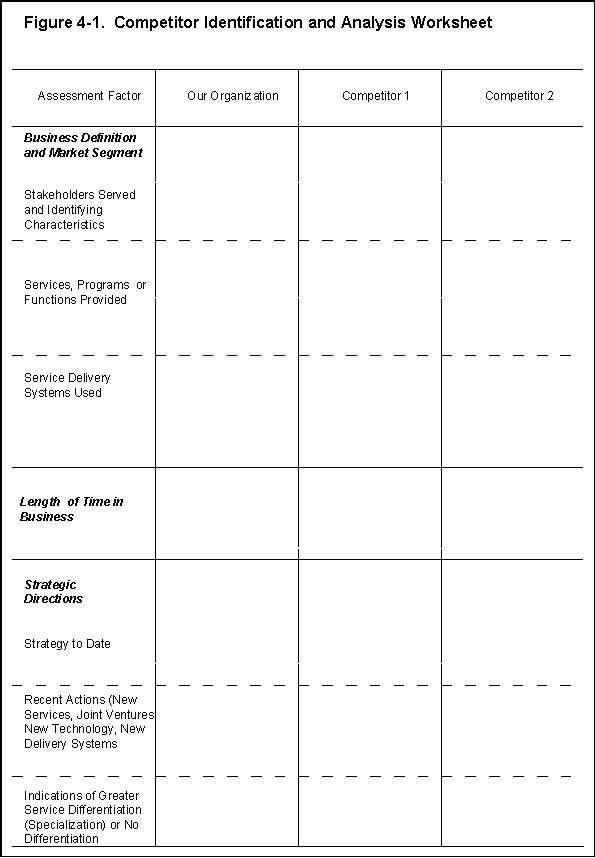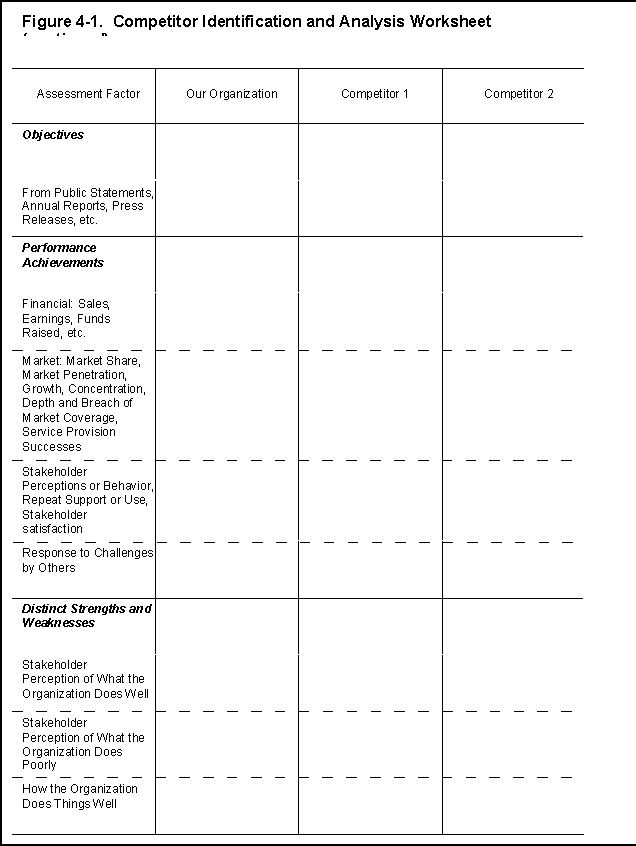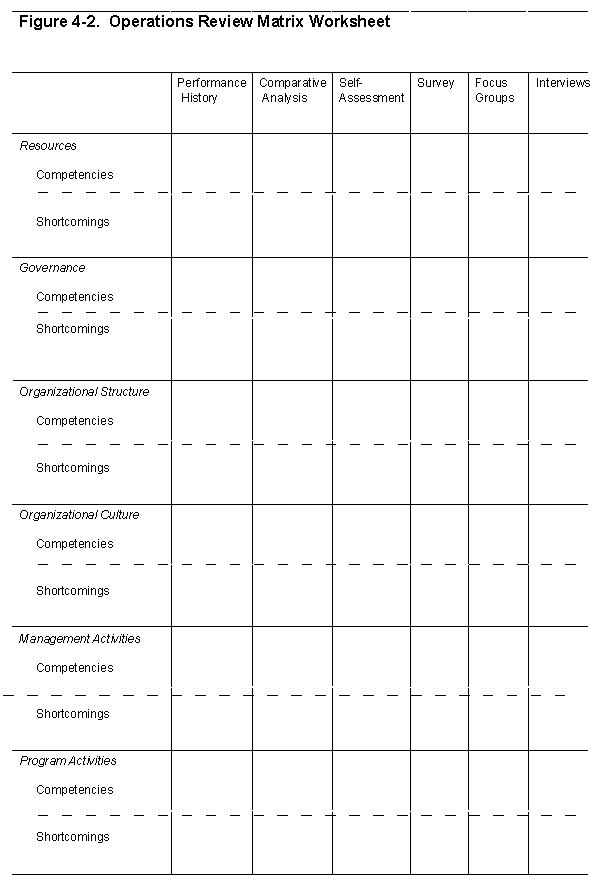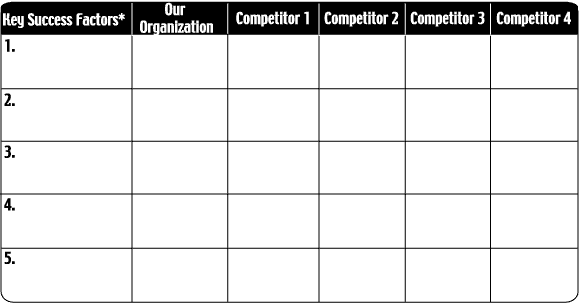MARKET RESEARCH: INTERNAL ANALYSIS Like external analysis, internal analysis is an information-gathering step. While external analysis looks at the world outside of the institution, internal analysis looks inward to identify your institutional strengths, weaknesses, and limitations. You can do internal analysis before, after, or the same time as external analysis. Internal analysis sizes up of your institution's internal capabilities and its competitive position. It focuses on your resources and your operations. The stages in internal analysis are described below. Deciding the scope of the analysis. The first decision you must make is what organizational resources and operations you will examine, or institutional scope. Ideally, your examination should be comprehensive--it should look at all of your institution's operations and resources. Next, decide what stakeholders you will involve in your assessment. The scope of involved stakeholders should be as broad as possible, but realistically limited by the resources available to conduct the assessment. Possible stakeholders to involve include faculty, staff, and students as well as trustees, political leaders, and parents. Finally, what competitors do you want to examine? For public postsecondary institutions, competitor scope may include corporate universities, and private for-profit and not-for-profit institutions as well as peer public institutions. Note that community colleges and university extension programs may all compete to serve the adult population in a particular area. Therefore, a survey of competition should be part of your external analysis. As part of your internal analysis, you may want to assess how your strengths and weaknesses compare with those of your competitors. Competitor analysis has great value in helping you to understand your institution's marketplace position. Deciding what methods to use. A number of methodological options are available for internal analysis, including those that measure your institution's past accomplishments and those that appraise key stakeholders' perceptions of your institution. Some methods are simple, requiring only a few hours. Other methods are elaborate and may involve several months of study and review. To a great extent, the availability of institutional resources (staff, money, time) will guide your choice of methods, including measures to examine performance history and comparative performance and methods to assess perceptions of your reputation. Comparative performance is a specialized performance history analysis that compares institutional performance in certain areas. For example, you may want to compare the average SAT score of entering first year students, or the percentage of students who graduate four years after initial enrollment, with your peer institutions. Perception analysis includes self-assessment, surveys, interviews, and focus groups. Self-assessment entails using an instrument that asks a series of questions about the institution. Respondents answer these questions based on their perceptions or understanding of how the institution is functioning. Self-assessment instruments may range from a short checklist to an extensive inventory. One advantage of self-assessment as an evaluation tool is that it can focus on very specific aspects of the institution. For example, one form of self-assessment available in standardized form is an institutional culture inventory. Faculty, students, staff, and administrators respond to a series of questions related to their perception of the institution's culture. Their responses can be combined into an overall institutional culture profile. Surveys are useful to ascertain how various stakeholders regard the institution and, possibly, its competitors. The aim is to evaluate the institution's operations and image. This type of survey can have a market research focus. Carefully consider whom to survey. There are a number of survey methods--telephone, door-to-door, on-the-street, and written survey forms sent through the mail or published in newspapers. Interviews are another way of testing perceptions about an institution. These are most typically one-to-one interviews with selected responses, although in some circumstances three to five persons may be interviewed at once. Interviews are generally time-consuming and expensive. They usually require about an hour per person, and there may be additional time and expense associated with traveling to the interview site. Focus groups are helpful in obtaining perceptions about the institution. This method gives everyone in the group a chance to respond to each question and enables the group to reach consensus. Groups may range in size from five to 20 members. Good questions to ask are:
To do a more comprehensive self-assessment, you can combine two or more of these methods. Using a variety of methods helps to compensate for weaknesses in any single method. Reach consensus on major strengths and weaknesses. Decide what your major competencies and shortcomings are in all designated operational and resource areas. Institutional Scope Institutional scope includes two major categories for examination: resources and operations. Resources are those things an institution can call upon to conceive, design, produce, market, finance, or manage its strategies. Resources include people, money, facilities and equipment, information, and technology. Operations include governance, institutional structure and culture, management activities, and program activities. You should assess your institution in both the resource and the operations areas. Resources People. An adequate human resource base must be in place to carry out institutional strategies. You can evaluate people by a number of criteria: levels of education, levels of experience, prominence in a substantive field, and technical awareness, to name a few. A basic question is this: Is the current staff and faculty adequate in numbers, qualifications, and skill levels for carrying out your institution's mission and strategies? Are your faculty and staff fully qualified? Are faculty members integrating technology into their instruction? Are administrators using up-to-date software to make their offices more efficient? Funds. Your success and effectiveness depends on the availability of financial resources. Therefore, assess the funds at hand to conduct operations. Examine your institution's income history, projected financial resource growth, and funding source dependability over the planning period. Some key questions to ask yourself are these: What source of funds do you use? What sources should you use? Given your present sources, what risks are you exposed to? What growth can you look forward to? Will any of your funding sources decline? How can you demonstrate to your funding sources that they are getting their money's worth? Facilities and Equipment. Your institution's facilities and equipment are additional resources. The basic question is this: Do facilities and equipment offer an adequate, appropriate work environment for staff, faculty, and students and do they project the right image to the public? Information. Access to information is a critical institutional resource. To function effectively, an institution must have adequate amounts of information. (An institution must also be able to manage information, an operational consideration discussed below.) The questions are these: What are your institution's sources of information about what goes on inside your institution and in the outside world? Does your institution need more information, or different sources, to carry out its operations effectively? Technology. Today, well-positioned institutions use new, laborsaving technologies as much as possible. Examine this use of technology and answer these questions: What systems are now automated? What are the needs and opportunities for further automation? (Consider applications like word processing and audiovisual technology for academic program delivery and staff training.) Operations Operations include governance, institutional structure, institutional culture, and management and program activities. At the least, you should assess management and program activities. Under management, you can look at activities such as personnel management, financial management, facilities management, institutional planning, management information systems, marketing, and communications. Each of these areas is detailed below in a fairly comprehensive inventory. An institution doing common sense management for the first time will not be likely to conduct a detailed assessment in each area, and will probably not examine every area listed. Governance Board of Trustees. A governing body, composed of citizen leaders representing diverse elements of the community, generally constitutes the board of trustees for a college. This board should function effectively in a decision-making role, directing your institution in the best interests of the community even while representing different segments. Assessment of a board should include a look at these areas:
Bylaws, Policies, and Procedures. Your institution should have a corporate charter (unless you are a governmental entity), bylaws, policies, and procedures that clearly define the scope of authority and responsibilities of the board, committees, and staff, and that establish procedures for governing your institution. Updating bylaws, policies, and procedures is necessary to maintain the procedures' relevance. Institutional Structure Your institution should have an organizational structure that enables it to accomplish its mission and objectives. There are different types of organizational structures. The traditional structure is hierarchical, similar to the military mode, with clear lines of authority. If your institution has this structure, the institutional chart is a pyramid, decisions being made at the top and flowing down to subordinates for execution. There are several alternatives to this structure. One alternative is the matrix or network structure. In the network structure, the institutional chart looks more like a spider web. Employees from different divisions come together to work on a specific task; traditional lines of hierarchy no longer hold. In this structure, workers are engaged as small entrepreneurs within your institution rather than as subordinates who only follow orders. Of course, there are hybrids between these two extremes. Whatever your institutional structure, your assessment should examine its efficiency in accomplishing your institution's business. Institutional Culture Books such as In Search of Excellence (Peters and Waterman, 1982) have popularized the concept of institutional culture. Institutional culture is a set of shared values, norms, beliefs, and expectations that keep everybody heading in the same direction. This set of shared elements may be reflected in an institution's daily rituals (e.g., arriving at work early), its heroes (usually the chief executive officer), its traditions (e.g., promotion from within), and its unspoken directives (e.g., "Don't rock the boat," "Don't share information with other groups"). Understanding institutional culture is critical because any attempts to bring about changes that fly in the face of this culture are apt to be short-circuited. When you attempt changes that do not fit your institution's culture, you may cause so much institutional strain and friction that the results are not worth the cost. Of course, institutional culture itself may change; it frequently changes with the appointment of a new chief executive officer. At times, boards will deliberately seek to change institutional culture by appointing a new executive. Institutional culture involves the perceptions and underlying values of faculty and staff that dictate their reactions to events. Assessment of the other categories listed here--governance, structure, and management and program operations--will reflect aspects of the corporate culture. Nevertheless, in institutional/competitor assessment, you should give some separate attention to defining this culture. In many respects institutional culture resembles a playing field on which your institution's players carry out strategic moves to succeed at their various endeavors. Successful strategies are devised and put into action with a sustained understanding of this culture. A description of institutional culture is important both in setting strategic directions and in developing strategies. Management Activities These activities help your institution function efficiently, enabling it to carry out its program and deliver its services. Management includes the following activities, each of which is detailed below. Personnel Management. All activities concerned with the use of personnel within your institution. An assessment of personal management should include a look at the following.
Financial Management. All activities related to handling your institution's finances. Specific aspects assessed include the following:
Facilities Management. All activities related to using and maintaining physical facilities and equipment. Aspects addressed include the following:
Institutional Planning. Planning that sets forth desired institutional accomplishments and proposed activities or outlines the steps to attain these accomplishments. Assessments may examine long-range strategic planning and short-term operational planning Management Information Systems. Systems that manage the compilation, storage, and retrieval of information used by your institution. Aspects examined may include use of computer technology, design and use of management information systems, and telecommunications. Marketing. Activities that develop and promote your institution's programs or services. These involve examining programs/service that meet stakeholder needs, assessing stakeholder satisfaction, and examining effectiveness of your market research strategies. Communication. Activities aimed at developing a dialogue with the community in order to promote understanding of, and interest in, your institution's mission and programs such as your information and educational services. Program Activities These are the "products" of your institution--the programs or services you provide to your clients or constituencies. For colleges and universities, these are curricular programs, housing programs, and community services. Primary program activities are as follows: Resource Development. Assessing development programs aimed at raising funds include examining fund and capital campaigns. Curriculum. Curriculum activities represent the major function of educational institutions, supplemented by student and administrative services. Internal assessment focuses on evaluating the effectiveness of curricular programs, student personnel programs, and instruction. Competitor Scope The second decision about the scope of institutional/competitor assessment involves identifying competitors. Other schools or institutions may be competing directly by offering the same services to meet the same set of stakeholder wants and needs, or indirectly by offering different services to meet the same set of stakeholder wants and needs. To identify competitors, an institution must first define its own business. Figure 4-1, Competitor Identification and Analysis Worksheet, provides a format for this identification. It includes answers to these questions:
Identify which other institutions are meeting the same wants and needs of these stakeholders. These institutions are competitors.
Stakeholder Scope An important decision related to the scope of your institutional/competitor assessment involves who will participate in it. This assessment may involve input from:
Representatives of these groups may be involved in planning the assessment and in reviewing or analyzing results to identifying major institutional strengths and weaknesses. Or they may just provide information during the data-gathering phase that will use one or more methodological options are available. Some are simple, requiring only a few hours. Other methods are elaborate and may involve several months of study and review. To a great extent, the availability of institutional resources (staff, money, time) will guide the choice of methods. Appendix 7 goes into some detail vis-à-vis methods of internal analysis. Selecting Appropriate Methods for Internal Analysis As noted above, resource considerations are paramount in selecting methods. Some methods are more expensive and time-consuming and require more staff expertise than others. In institutional/competitor assessment, it is best to use a variety of methods for a well-rounded picture. (Appendix 7, Selecting Appropriate Methods for Internal Analysis, describes several considerations for selecting various methods.). Different methods reveal different strengths and weaknesses of your institution. For example, surveys and focus groups will point to schools' strengths and weaknesses in functions most visible to large numbers of community leaders. Content analysis will provide more insight into strengths and weaknesses over a period of time in such areas as governance, institutional structure, and financial management. Self-assessment will target strengths and weaknesses specifically related to operational tasks and whether or not they are carried out, tasks such as the periodic updating of staff job descriptions. Taken together, these methods become a powerful tool for gaining a detailed understanding of institutional strengths and weaknesses. Identify Competencies and Shortcomings Once you have fully assessed your institution's resources and operations, you then must develop a precise but comprehensive statement of your institution's competencies and shortcoming. Do this by looking first at your institution and then at the services offered by specific competitors. This helps you understand what your special strengths are compared to those of your competitors. With this understanding of your market position, you can build on your strengths in the common sense management process, address weaknesses, and carve your own special niche in the marketplace. In compiling data for competencies and shortcomings, summarize what you have learned about your institution and what you have found out about your competitors. Comparing your school with competitors assists you in describing the unique competencies, shortcomings and market position of your school. Competencies and Shortcomings To describe your institution's competencies and shortcomings, synthesize findings from the various methods described in the resource and operations categories listed above under Determining the Scope of the Assessment. For instance, a summary might start off with a review of institutional resources, touching on strengths and weaknesses with respect to people, money, technology, information and facilities. It might then move on to the operations area, touching on institutional strengths and weaknesses related to governance, institutional structure, institutional culture, management activities, and curriculum; these will have been uncovered through content analysis, self-assessment, interviews, or other methods. A useful way to display this summary is to create a matrix showing responses gathered by the various methods. Figure 4-2, Operations Review Matrix Worksheet, provides such a format. The final product is a single listing of competencies and shortcomings related to specific institutional elements. If you want to understand your position as compared with those of actual or potential competitors, you must also compile whatever information you can about your competitors. To do this, identify competitors (as described in Competitor Scope above). Using a format like that described on the Competitor Identification and Analysis Worksheet (Figure 4-1), compare basic data on each major competitor with the same data about your school. First, list your institution and its major competitors at the top. The worksheet blocks, as noted from the listing on the left-hand side, cover such areas as the services and programs your institution provides to meet stakeholder needs, the geographic areas it covers, the service delivery system it uses, its strategic directions, its performance achievements, its distinct institutional strengths and weaknesses, and its core capabilities. You may find this information about competitors in their annual reports, news releases, reports to charitable registration bodies, and advertising brochures. Next, identify the key success factors that make the difference between success and failure. The Key Success Factor Assessment Worksheet (Figure 4-3) provides a format for assessing these factors. Key success factors have an industry-wide, external focus; they are the primary factors stakeholders consider in choosing one institution's service over those of another. Some key success factors for any educational institution might be these:
The key success factors are those that differentiate the winners from the losers in higher education. These factors are the attributes and capabilities most necessary to your institution if it is to surpass your competitors in meeting stakeholders' needs.
Market Position The final step is identify your institution's market position vis-a-vis your competitors. Using the Key Success Factor Assessment Worksheet, list key success factors in the left-hand column. Looking at the data detailed in the Competitor Identification and Analysis Worksheet, pick out evidence of institutional performance on these factors and then rate this performance using the scale at the bottom of the worksheet. For a strategic perspective, conduct a separate analysis for potential or future key success factors. The total ratings on the Key Success Factor Assessment Worksheet will highlight your position in the marketplace, revealing what your institution is doing well and what not so well--by comparison with its competitors--in your effort to meet stakeholders' needs. This analysis points to areas where there is potential for growth, need for corrective action, or room for new strategy development. In establishing market position, you should aim to establish and maintain a distinctive place in the market. Seek to develop an "image" among stakeholders, one that emphasizes a unique ability to provide an academic program that meets needs differently (and better) than competitors. Selecting Major Competencies and Shortcomings Determining competencies and shortcomings of your institution may result in a lengthy assessment, especially if you use several methods. To work through the strategic management process efficiently, you need a pared-down list of competencies and shortcomings that summarize major or key competencies and shortcomings on a few pages. These are the strengths you must build upon and the weaknesses you must remedy if you are to successfully implement the strategies proposed in the next step--strategic direction-setting. Your institutional assessment committee may designate these major strengths and weaknesses after it reviews a summary report of institutional competencies and shortcomings. Of the methods available for group decision-making, the nominal group technique or focus groups are most appropriate at this stage to aid the committee in coming to an agreement. Shortcuts for Internal Analysis Of all the methods described in this chapter, the focus group is the quickest and easiest to implement, while standing on its own as a relatively comprehensive institutional assessment. You might devote two or three days to conducting 9 to 12 focus groups among stakeholders, including trustees, faculty, staff and students. Or you may use focus groups as part of a two-day, one-day, or half-day common sense management process. Another way to shorten the process is to narrow the scope of the assessment. You may eliminate or cut detail for some of the assessment elements listed in the section describing the scope of the assessment. For example, the assessment may focus only on selected management and program operations. Surveys vary greatly in the resources they require. You may want to restrict your summary a short one-or two-page survey of key leadership figures. Another approach is to conduct three or four focus groups and use the results to craft a survey to send to a broader selection of stakeholders. How To Get Started The first step is to form a committee to oversee your internal analysis process. The committee should include senior administrators as well as research staff. This committee is responsible for the following tasks:
Once Institutional/Competitor Assessment is Completed, What's Next? The information you have compiled in this step contributes to strategic direction setting, described in the next chapter. The results of the external analysis also feed into strategic direction setting. Generally, internal analysis and external analysis will be conducted concurrently. These external and internal analyses provide the basis for identifying the strategic issues most critical to your institution and for identifying the capacities needed to manage them. The Product from Internal Analysis After you gather information using one or more of the methods outlined, develop a precise and comprehensive statement of your institution's competencies and shortcomings. Synthesize findings from the various methods under the resource and operations categories listed above. Your summary might start off with a review of institutional resources, touching on strengths and weaknesses with respect to people, money, technology, information, and facilities. It might then move on to the operations area, touching on institutional strengths and weaknesses related to governance, institutional structure, institutional culture, management activities, and program activities. In this summary, identify what stands out as your institution's major competencies and shortcomings. If you have done a competitor analysis, report how you stack up against your competitors in these major areas. The summary you develop will be used, along with your external analysis, to establish a vision for your institution and to determine your critical issues in the strategic direction step of the common sense management process.
|



